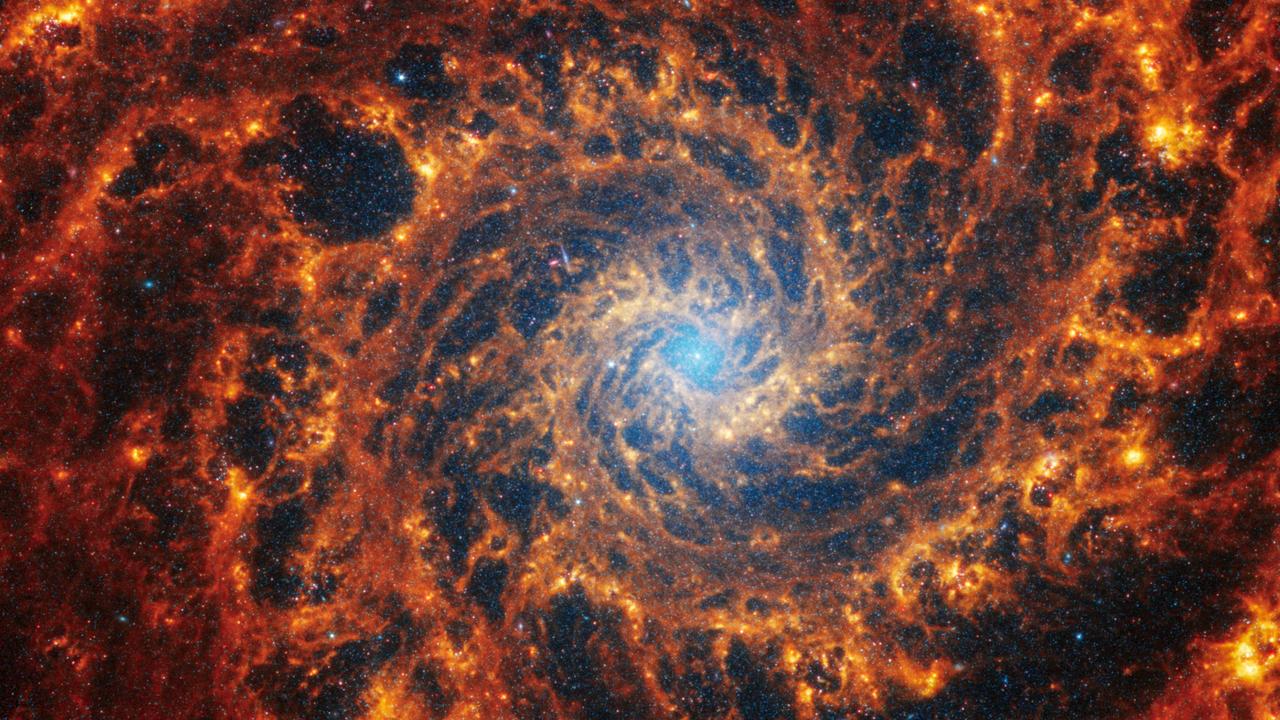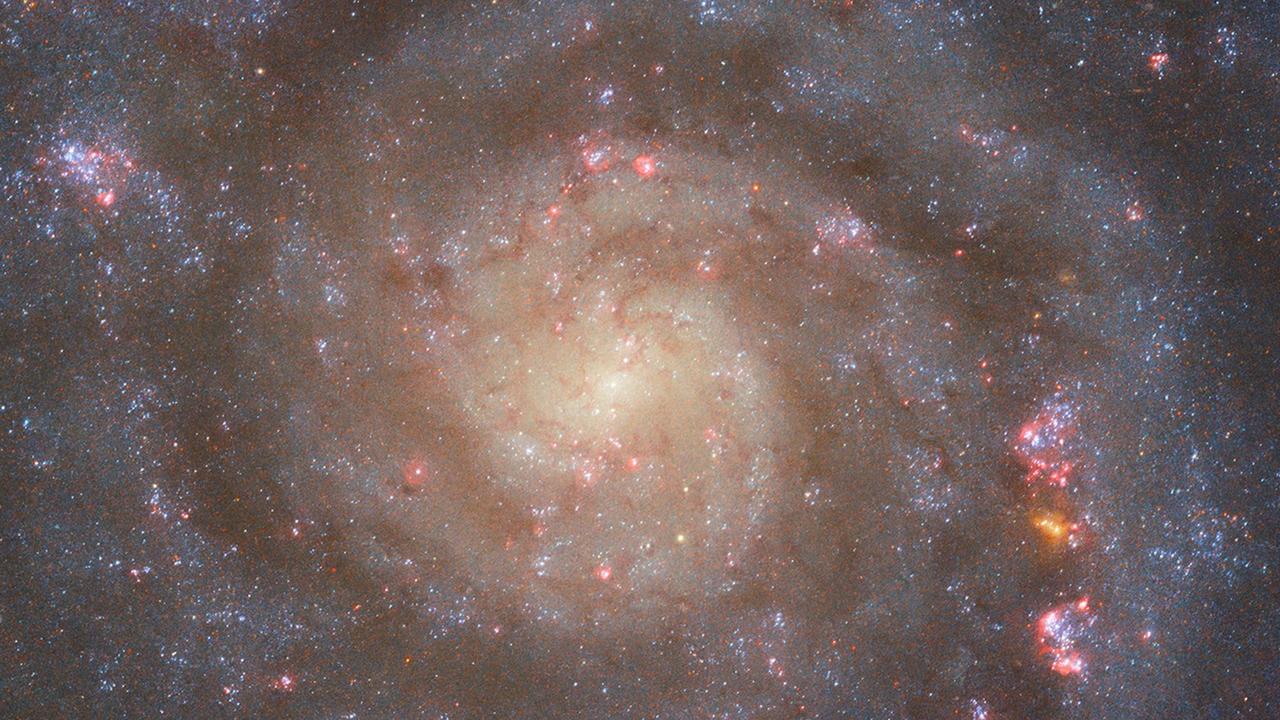New photos give scientists clues into the way stars are formed
Groundbreaking images taken by the James Webb Space Telescope have given scientists a never-before-seen view of our closest galaxies, offering fresh views into the way stars are formed

READING LEVEL: ORANGE
Images taken by NASA’s James Webb Space Telescope have given scientists new clues about the way stars and galaxies are formed.
The photos showed 19 spiral galaxies considered relatively close to our own galaxy, the Milky Way.
Using infra-red, the James Webb Space Telescope, or JWST, was able to capture images of stars usually hidden behind clouds of gas and dust that scientists hadn’t been able to see previously using the older technology of the Hubble Space Telescope.
The images showed there had been explosive activity and some clearing of space dust in the formation of the stars photographed.
“These data are important as they give us a new view on the earliest phase of star formation,” said University of Oxford astronomer Dr Thomas Williams, head of data processing for the team of scientists doing the research called Physics at High Angular resolution in Nearby Galaxies (PHANGS).

“Stars are born deep within dusty clouds that completely block out the light at visible wavelengths – what the Hubble Space Telescope is sensitive to – but these clouds light up at the JWST wavelengths,” Dr Williams said. “We don’t know a lot about this phase, not even really how long it lasts, and so these data will be vital for understanding how stars in galaxies start their lives.”
The closest of the 19 galaxies captured is called NGC5068, which is about 15 million light years from Earth. The most distant galaxy is NGC1365, which is about 60 million light years from Earth.
A light-year is the distance light travels in a year, or, 9.5 trillion km.
The photos showed about 100,000 star clusters and millions, or maybe billions, of individual stars.


WHAT IS A SPIRAL GALAXY?
Spiral galaxies are a common galaxy type that looks like an enormous pinwheel. Our Milky Way is a spiral galaxy.
About half of spiral galaxies have a straight structure, called a bar, coming out from the galactic centre to which the spiral arms are attached.
“The commonly held thought is that galaxies form from the inside-out, and so get bigger and bigger over their lifetimes,” Dr Williams said. “The spiral arms act to sweep up the gas that will form into stars, and the bars act to funnel that same gas in towards the central black hole of the galaxy.”
WHAT IS THE JAMES WEBB SPACE TELESCOPE?
The James Webb Space Telescope (JWST) was launched in 2021 and began collecting data in 2022, reshaping humanity’s understanding of the early universe while taking amazing pictures of the cosmos. The orbiting observatory looks at the universe mainly in the infra-red. The Hubble Space Telescope, launched in 1990 and still operational, has examined it using optical and ultraviolet wavelengths.
POLL
GLOSSARY
- infra-red: a type of radiant energy that we can’t see with the naked eye but feel as heat
- formation: shape or the way something forms
- wavelengths: pattern and distance of radiant energy
- ultraviolet: a type of radiant energy that is emitted by the sun as UV rays
- optical: a type of radiant energy that is visible to the human eye as light
EXTRA READING
Euclid space shots stun Earthlings
Elon Musk: Rocket explosion won’t stall Mars mission
Saturn’s rings to disappear from view by 2025
QUICK QUIZ
1. What is a spiral galaxy?
2. Why are the James Webb images exciting for scientists studying the way stars are formed?
3. What is the name of the older telescope mentioned that was launched in 1990?
4. How many galaxies were captured in the James Webb photographs?
5. How many star clusters were captured in the photos?
LISTEN TO THIS STORY
CLASSROOM ACTIVITIES
1. Space maths
There are lots of facts and figures about space in the article. Using data found in the article, see if you can work with a friend to solve some of the maths equations below;
1. What is the difference between the closest and most distant galaxy from earth in light years?
2. What would be the mathematical equation to work out how far the closest galaxy is in terms of kilometres?
3. How was the Hubble Space Telescope different to the newer James Webb space telescope?
(Answers below)
Time: allow 15 minutes to complete this activity
Curriculum Links: Mathematics, Science, Personal and Social, Critical and Creative thinking
2. Extension
If you were able to name a whole new galaxy, what would you call it? Explain your reasons.
Time: allow 10 minutes to complete this activity
Curriculum Links: Science, Critical and Creative Thinking
* Answers:
1. 45 million light years
2. 15 million (light years) x 9.5 trillion kilometres
3. Hubble telescope used optical and ultraviolet wavelengths, James Webb telescope uses infra-red.
VCOP ACTIVITY
Read this!
A headline on an article – or a title on your text – should capture the attention of the audience, telling them to read this now. So choosing the perfect words for a headline or title is very important.
Create three new headlines for the events that took place in this article. Remember, what you write and how you write it will set the pace for the whole text, so make sure it matches.
Read out your headlines to a partner and discuss what the article will be about based on the headline you created. Discuss the tone and mood you set in just your few, short words. Does it do the article justice? Will it capture the audience’s attention the way you hoped? Would you want to read more?
Consider how a headline or title is similar to using short, sharp sentences throughout your text. They can be just as important as complex ones. Go through the last text you wrote and highlight any short, sharp sentences that capture the audience.

